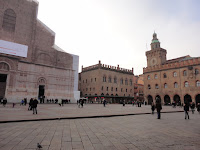In America we have a pre-conceived notion of what “college-life” is all about. Large, beautiful campuses, football games, frat parties, meal plans, dorms, etc. However, the Italian university system is an entirely different system (and I’m still confused about a lot of it!). For one, Italians rarely have homework or assignments, and written exams are sparse. You may be thinking to yourself that this sounds like a complete joke. But I would argue that Italians study more than your average American college student. While they may not have daily or weekly assignments to worry about, they have a final, ORAL exam at the end of the semester to prepare for. A task especially daunting for an American student speaking Italian as a second language, the Italian students study weeks, if not months in preparation for these tests. All for a 15 minute conversation with the professor. And these exams aren’t conducted privately either. You show up for class like you would for any other lecture, and one by one the professor calls down each student by name to take his or her oral exam consisting of three questions – if you are lucky enough to receive a third. Students who fare too poorly at the beginning don’t even make it to three questions. Yes, I will have to take two of these oral exams, no, I can’t take them in English, and yes, I am scared out of my mind. However, our program director is widely known and respected at the university and always makes sure we are enrolled in classes with professors who are understanding of students foreign to the language, so hopefully, non sarebbe un problema! Also, we have been told that here, the professors are the Emperors and their classrooms are their Empire. What they say goes. They are highly respected, and have much more power than professors do at American universities.
Bologna is also widely known for its prosciutto, of which there seem to be a million different kinds. You don’t order a sandwich with turkey and American cheese, but instead a panino with prosciutto and mozzarella. Additionally, everything is FRESH, which makes it all the more delicious. When we went on our mini-tour of Bologna we were also privileged enough to get to visit to of its best restaurants. The first was a pasticceria that made some of the best, most traditional “Pane Bolognese” (Bologna bread, essentially), which comes in ridiculous shapes that I couldn’t even begin to describe. We tasted a few different kinds of pane there (some even baked with prosciutto on the inside), as well as some “dolce” made with pane and latte (milk). The second place we visited was a vegetarian’s nightmare. Endless rows of meat and prosciutto were strung across the ceiling in addition to the innumerable assortments of meat readily on display behind glass cases. Here we were treated to a pranzo (lunch) consisting of prosciutto, salami, bologna, cheeses, bread, and wine – all of divine quality. It was outstanding. While our program may require us to do a lot of things on our own, they sure do treat us well. But seriously, I don’t think I have ever eaten so much pasta in my life. I know that was to be expected when I came here, but I’m not sure I was quite ready for how GOOD it would be. Not only that, but food is an integral part of the culture here. For how stingy Italians can be when it comes to phones, they are not hesitant to indulge in and splurge on good food. (Here, most everyone has pre-paid plans and unlike America, you don’t get charged for any incoming calls or texts – “SMS’s”. As such, it is common to pick up the phone and call someone, let it ring, and then hang-up before the other person picks up. The purpose of this is to make someone else call you when you need to talk to them. Strange, I know, but also a bit comical). We also took a trip to a ristorante called Ristorante La Traviata for a night of pasta making and eating. We arrived and were greeted by two adorable women who worked there, and who would be responsible for teaching us how to properly make pasta by hand. They equipped us with eggs and flour and we were put to work at once, mixing, stirring, and mushing until a solid yellowish dough emerged. Then came the rolling and the flattening, and finally, the cutting and shaping. I'm making this sound a lot easier than it really was, but that is a quick run-down of the process. It was such a cool experience. The women were extremely nice and taught us so much about Italian cuisine. Afterwards, they prepared our homemade farfalle and tagliatelli in ragu and cream sauces and we feasted. It was DELICIOUS. I never want to eat pasta from a box again. (I will, of course, but it was THAT good).

The final product - homemade Farfalle!

The secret "pinch" to making a perfect Farfalle!

The beginning of homemade pasta

La Macelleria (meat shop) we went to on our walking tour.

Our feast of Prosciutto, Salami, Bologna, Cheese, Bread, and Wine.

One of the oldest classrooms at the university used for studying anatomy.



















